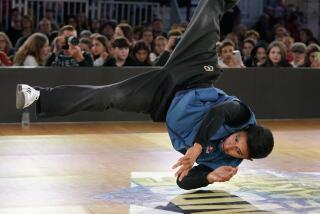Boycott Is the Great Equalizer
- Share via
YAMANOUCHI, Japan — The most important thing to know about the men’s snowboarding halfpipe competition Thursday is who’s not at the Winter Games.
Norway’s Terje Haakonsen.
If you ask the Canadians, he’s the Wayne Gretzky of the sport. If you ask the Americans, he’s the Michael Jordan.
“It’s a disappointment for us that he’s not here,” the United States’ leading medal contender, Todd Richards, said of the sport’s most creative and artistic flier. “Naturally, we’d like for the best competition to be in the Olympics.
“But it was his decision not to come. I don’t necessarily agree with it, but I respect it.”
Haakonsen, who lives in Laguna Beach, staged a personal boycott because of the politics revolving around snowboarding’s admittance into the Olympics, firing a salvo on behalf of the fiercely independent riders by comparing the IOC to the Mafia and its president, Juan Antonio Samaranch, to Al Capone.
Even so, Haakonsen is such an icon in the sport that even Samaranch expressed regret at the Norwegian’s absence.
“But participation in the Olympic Games is not compulsory,” Samaranch said. “Those who don’t experience the Games are the losers.”
The women also compete Thursday, and the best are here, including the Queen of Big Air, Barrett Christy, 27, of Breckenridge, Colo., who won two events in last year’s Winter X Games, and Michele Taggart, 27, of Salem, Ore. Among their teammates is Cara-Beth Burnside, a 1995 world championship silver medalist from Orange.
Instead of testing themselves against a clock, like their giant slalom cousins, halfpipe experts perform tricks on a U-shaped channel of snow and are judged in categories such as amplitude, landings, rotations, standard airs and technical merit.
The sport’s lingo is as colorful as its athletes, with tricks such as McTwists, rodeo flips, stale fish, stiffys, tweaks, alley-oops, fakies, ho-hos and lip tricks.
Breckenridge could score a double because Richards, 28, also lists it as his hometown. He has been designated as the favorite in Haakonsen’s absence, but others who are considered contenders are American Ross Powers of South Londonderry, Vt., Finland’s Markus Hurme, Norway’s Roge Hjelmstadstuen and Switzerland’s Fabien Rohrer.
Richards, the defending U.S. Open champion and a winner of one Grand Prix this season and a runner-up in another, had little difficulty resolving his conflict about whether to compete in the Olympics.
“There’s a fine line between selling out and buying in,” he said. “It’s a little bit unusual being part of a team, wearing the uniform and all that. But it’s all about showing the world’s best talent. If we have to do some things that are unusual for us, that’s OK.”
Besides, even if he wins a gold medal, Richards doesn’t believe he will ever be considered part of the mainstream.
A skateboarder on dry land, he said, “I’ll still get chased out of malls and grocery store parking lots.”
(BEGIN TEXT OF INFOBOX / INFOGRAPHIC)
SNOWBOARDING
The Halfpipe
Todd Richards of the United States and fellow competitors ride back and forth on a course shaped like a cylinder cut into the snow, performing jumps, twists, spins and other aerial manuevers above the halfpipe’s rim. Eight to ten moves or “hits” are made per run. Competitors are judged on basic manuevers, aerial rotation, height, landing and technical merit.
The Course
Kanbayashi Snowboard Park, Tamanouchi
Length: 394 feet
Width: 49 feet
Wall height: 11 feet
Avg. gradient: 18 degrees
More to Read
Go beyond the scoreboard
Get the latest on L.A.'s teams in the daily Sports Report newsletter.
You may occasionally receive promotional content from the Los Angeles Times.






